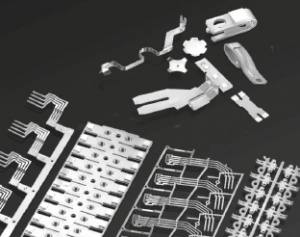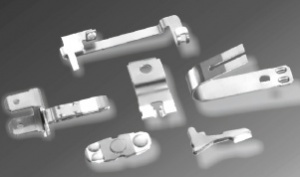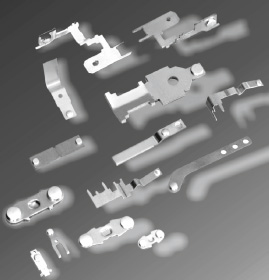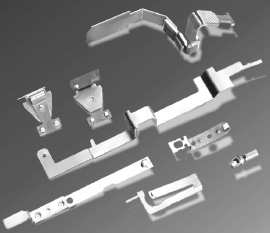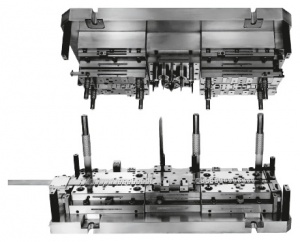Difference between revisions of "Stanzteile"
Teitscheid (talk | contribs) (temp edit) |
Teitscheid (talk | contribs) (temp edit) |
||
| Line 23: | Line 23: | ||
| − | === | + | ===Ausführungsformen von Stanzteilen=== |
| − | + | Stanzteile werden als Einzelteile, als vorgestanztes Band oder in Kammform | |
| + | hergestellt. Je nach Anforderung und Verwendungszweck sind Kontakt- und | ||
| + | Trägerwerkstoffe sowie die Beschichtungs- und Verbindungstechnik | ||
| + | unterschiedlich. | ||
| − | * | + | *Beschichtete Stanzteile |
| − | + | Stanzteile können sowohl selektiv als auch ganzflächig mit Edelmetallen auf Basis von Gold, Palladium und Silber sowie Unedelmetallen wie Zinn, Nickel beschichtet werden. | |
| − | |||
| − | |||
| − | |||
| − | |||
| − | |||
| − | + | Bei Stanzteilen, die in großen Stückzahlen z.B. für den Einsatz als elektrische Funktionsbausteine im Kfz zum Einsatz kommen, wird das Schichtmaterial meist im „Reel-to-Reel“- Verfahren aufgebracht, wobei von Vollband oder vorgestanztem Band ausgegangen wird (s. Abschn. [[Galvanische_Beschichtung)#Galvanische Beschichtung von Halbzeugen| Galvanische Beschichtung von Halbzeugen]]). Häufig wird das vorgestanzte, beschichtete Band in Verbindung mit der Montage des Endproduktes weiterverarbeitet. Alternativ können die fertiggestanzten Einzelteile als Trommel- oder Gestellware beschichtet werden. | |
| − | + | Nach galvanischen Verfahren werden dünnste Schichten innerhalb enger | |
| + | Fertigungstoleranzen abgeschieden. Die hohe Verschleißfestigkeit derartiger | ||
| + | Schichten ist für viele Anwendungen von Vorteil. Da bereits dünnste Überzüge | ||
| + | weitgehend porenfrei sind, eignen sie sich als Korrosionsschutzschicht. Art der | ||
| + | Beschichtung sowie Schichtfolge und Dicke der Überzüge z.B. als Funktionsschichten | ||
| + | in Steckverbindern werden auf die Anforderungen im Anwendungsfall | ||
| + | abgestimmt. | ||
| − | + | *Plattierte Stanzteile | |
| + | |||
| + | Für viele Anwendungen sind dickere Edelmetallschichten oder AlSi-Schichten | ||
| + | erforderlich, die auf galvanischem Wege nicht wirtschaftlich auf Trägerwerkstoffe | ||
| + | aufgebracht werden können. Häufig kommen funktionsbedingt neben | ||
| + | schmelzmetallurgisch hergestellten Werkstoffen auf Gold-, Palladium- und | ||
| + | Silberbasis auch Werkstoffe zum Einsatz, die nach pulvermetallurgischen Fertigungsverfahren | ||
| + | hergestellt wurden. Die stoffschlüssige Verbindung zwischen | ||
| + | Kontaktwerkstoff und dem meist aus Kupfer oder Kupferlegierungen bestehenden | ||
| + | Trägerwerkstoff erfolgt nach verschiedenen mechanischen Plattierverfahren | ||
| + | (s. Abschn. [[Manufacturing of Semi-Finished Materials#Clad Semi-Finished Pre-Materials (Contact-Bimetals)| Clad Semi-Finished Pre-Materials (Contact-Bimetals)]]). Auf diese Weise werden auch aluminiumplattierte Bänder | ||
| + | hergestellt, bei denen die Aluminiumschicht als bondfähige Oberfläche an der | ||
| + | Schnittstelle zwischen elektromechanischen Anschlussstellen und elektronischen | ||
| + | Schaltkreisen dient. | ||
| + | Die plattierten Halbzeuge können | ||
| + | als vorgestanzte Bänder, in Kammform | ||
| + | oder als Einzelteile weiterverarbeitet | ||
| + | werden <xr id="fig:Examples of clad stamped parts"/><!--(Fig. 3.18)-->. | ||
<figure id="fig:Examples of clad stamped parts"> | <figure id="fig:Examples of clad stamped parts"> | ||
| − | [[File:Examples of clad stamped parts.jpg|right|thumb| | + | [[File:Examples of clad stamped parts.jpg|right|thumb|Beispie le für plattierte Stanzteile]] |
</figure> | </figure> | ||
Revision as of 13:41, 21 September 2014
Stanzteile
Stanzteile für die Kontakttechnik bestehen üblicherweise aus Trägerteilen, auf die nach verschiedenen Verfahren Kontaktmaterial aufgebracht ist Figure 1.
Sie sind wichtige Funktionselemente in einer Vielzahl von Anwendungen in Schaltgeräten und elektromechanischen Bauelementen der Elektrotechnik und Elektronik. Einerseits ermöglichen sie eine weitgehend verlustfreie Stromübertragung und sicheres Schließen und Öffnen von Stromkreisen, andererseits sind die Trägerteile wichtige Konstruktionselemente, die entsprechend den Anforderungen hinsichtlich elektrischer, thermischer, mechanischer und magnetischer Eigenschaften ausgewählt sind.
Die zunehmende Miniaturisierung elektromechanischer Bauelemente erfordert immer mehr Stanzteile mit kleinen geometrischen Abmessungen und sehr hoher Maßgenauigkeit. Derartige Präzisionsstanzteile sind erforderlich, um zuverlässige Schalt- und Verbindungsfunktionen im Bereich der Automobiltechnik zu gewährleisten. In Relais, Schaltern und Steckverbindern der Mess- und Regelungstechnik sowie der Informations- und Datentechnik übertragen sie mit hoher Zuverlässigkeit Signale und Steuerbefehle und sorgen so für einen sicheren Datentransfer zwischen Elektrotechnik und Elektronik.
Ausführungsformen von Stanzteilen
Stanzteile werden als Einzelteile, als vorgestanztes Band oder in Kammform hergestellt. Je nach Anforderung und Verwendungszweck sind Kontakt- und Trägerwerkstoffe sowie die Beschichtungs- und Verbindungstechnik unterschiedlich.
- Beschichtete Stanzteile
Stanzteile können sowohl selektiv als auch ganzflächig mit Edelmetallen auf Basis von Gold, Palladium und Silber sowie Unedelmetallen wie Zinn, Nickel beschichtet werden.
Bei Stanzteilen, die in großen Stückzahlen z.B. für den Einsatz als elektrische Funktionsbausteine im Kfz zum Einsatz kommen, wird das Schichtmaterial meist im „Reel-to-Reel“- Verfahren aufgebracht, wobei von Vollband oder vorgestanztem Band ausgegangen wird (s. Abschn. Galvanische Beschichtung von Halbzeugen). Häufig wird das vorgestanzte, beschichtete Band in Verbindung mit der Montage des Endproduktes weiterverarbeitet. Alternativ können die fertiggestanzten Einzelteile als Trommel- oder Gestellware beschichtet werden.
Nach galvanischen Verfahren werden dünnste Schichten innerhalb enger Fertigungstoleranzen abgeschieden. Die hohe Verschleißfestigkeit derartiger Schichten ist für viele Anwendungen von Vorteil. Da bereits dünnste Überzüge weitgehend porenfrei sind, eignen sie sich als Korrosionsschutzschicht. Art der Beschichtung sowie Schichtfolge und Dicke der Überzüge z.B. als Funktionsschichten in Steckverbindern werden auf die Anforderungen im Anwendungsfall abgestimmt.
- Plattierte Stanzteile
Für viele Anwendungen sind dickere Edelmetallschichten oder AlSi-Schichten erforderlich, die auf galvanischem Wege nicht wirtschaftlich auf Trägerwerkstoffe aufgebracht werden können. Häufig kommen funktionsbedingt neben schmelzmetallurgisch hergestellten Werkstoffen auf Gold-, Palladium- und Silberbasis auch Werkstoffe zum Einsatz, die nach pulvermetallurgischen Fertigungsverfahren hergestellt wurden. Die stoffschlüssige Verbindung zwischen Kontaktwerkstoff und dem meist aus Kupfer oder Kupferlegierungen bestehenden Trägerwerkstoff erfolgt nach verschiedenen mechanischen Plattierverfahren (s. Abschn. Clad Semi-Finished Pre-Materials (Contact-Bimetals)). Auf diese Weise werden auch aluminiumplattierte Bänder hergestellt, bei denen die Aluminiumschicht als bondfähige Oberfläche an der Schnittstelle zwischen elektromechanischen Anschlussstellen und elektronischen Schaltkreisen dient. Die plattierten Halbzeuge können als vorgestanzte Bänder, in Kammform oder als Einzelteile weiterverarbeitet werden Figure 2.
- Welded stamped parts
Welded stamped parts can be fabricated by various methods (see also chapter Welding Processes). Single contact pieces can be attached to pre-stamped or finished stamped strips as weld buttons and wire or profile segments by electrical resistance welding. Contact parts can also be stamped from seam-welded semi-finished strip. Fitting the end application contact materials based on gold, palladium and silver. Depending on the contact material and the design of the finished contact component the contact bottom surface may be consist of a weldable backing material.
- Brazed stamped parts
Brazed stamped contact assemblies are manufactured by two joining methods (see also chapter Brazing Processes). The contact material is either attached by resistance or induction brazing to base metal carriers as prefabricated contact tip or they are stamped from brazed semi-finished toplay strip. It is typical for brazed contact parts that the contact material consists of silver based contact material and a good conducting copper base material with larger cross-sectional area for the usually higher current carrying capacity.
- Stamped contact parts with rivets
Riveted stamped contact parts are manufactured with the use of contact rivets which are transferred over suitable feed mechanisms correctly oriented into holes punched into the carrier Figure 3. Frequently also wire or wire segments resp. are used which are subsequently coined and formed into the desired contact shape (see also chapter Mechanical Attachment Processes). Both attachment methods have their distinct advantages. Using composite or tri-metal rivets allows limiting the use of precious metal custom tailored to the volume needed for specific switching requirements. For wire staking the precious metal usage is usually higher but the staking can be performed at significantly higher production rates and the additional rivet making step is eliminated.
- Pre-mounted component stamped parts
Components stamped parts consist of a minimum of two carrier parts which differ in their material composition and geometrical form and the contact material Figure 4. The assembly of these components as single pieces or stamping progressions is performed in a stamping die by riveting or coining. To increase the current carrying capacity at the joining area an additional welding step can be added. Depending on the requirements the different properties of the two carrier components can be combined. As an example: the high electrical conductivity of a contact carrier blade is joined with the thermal or mechanical spring properties of a second material to form a functional component. For this process both carrier base materials can also be coated with additional layers of other functional materials.
Stamped parts which are insert molded into or combined with plastic parts are used in electromechanical components (see Chapter Electromechanical Components ).
Stamping Tools
For the design of stamping tools the latest CAD software systems are used. Modern stamping tools usually employ a modular design with integrated dimensional and functional controls Figure 5.
Depending on the requirements on the parts and the volumes they are built with steel or carbide (-steel) inserts which are coated with a wear resistant material such as for example TiN for longer life.
A special stamping process is precision stamping for contact parts made from thin strip materials with thicknesses in the range of 0.05 – 2.5 mm. With high capacity stamping technology up to 1400 strokes/min can be reached for high volume parts. During the actual stamping operation frequently other processes such as thread-forming, welding of contact segments and insertion and forming of contacts from wire segments are integrated. Depending on the production volumes these operations can also be performed in multiples.
The quality of the tools used for stamping, like progressive dies and stamp-forming tools is important for the final precision and consistency of the parts. During high speed stamping the tools are exposed to extreme mechanical stresses which must be compensated for to ensure the highest precision over long production runs. With such high quality progressive dies parts of high precision with a cutting width of less than the material thickness and with strict quality requirements for the cutting surfaces can be manufactured. To ensure the highest demands on the surface quality of precision contact parts quite often vanishing oils are used as tool lubricants. Cleaning and degreasing operations can also be integrated into the stamping process. Additionally most stamping lines are also equipped with test stations for a 100% dimensional and surface quality control. During the design of stamping tools for electrical contacts minimizing of process scrap and the possibility to separate the precious metal containing scrap must be considered.
